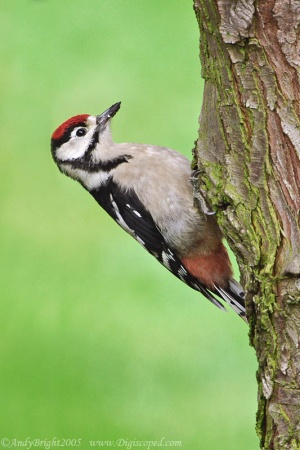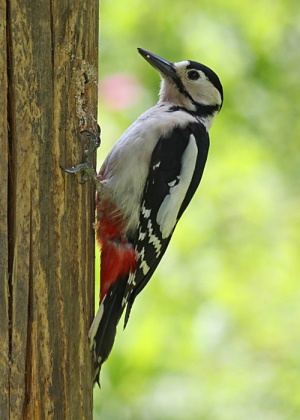- Dendrocopos major
Picoides major
Identification
L. 23-26 cm
Ws. 38-44 cm
- Glossy black upper parts
- White on the sides of face and neck
- Large white shoulder patch
- Barred black and white flight feathers
- Three outer tail feathers barred
- Buffish white under parts
- Crimson abdomen and undertail coverts
- Slate black bill
- Greenish grey legs
The male has a crimson spot on nape, which is missing on the female. Immatures also have no nape spot, but the crown is crimson.
Similar Species
Similar to the the smaller Lesser Spotted Woodpecker
Distribution
One of the most widespread and abundant of the spotted woodpeckers, breeds throughout Britain, most of Scandinavia except the far north and the highest mountains, throughout Europe from Iberia (although scarce in southern Spain) to northern Greece and east to Kamchatka, Sakhalin, Japan, Korea and China.
Also breeds on the Canary Islands, Corsica, Sardinia and Sicily and isolated populations in the Caucasus and in parts of southern Greece and northern Turkey, in Morocco and northern parts of Algeria and Tunisia. Further east the southern limits of range are reached in north-east India, Vietnam and Hainan.
Resident throughout range but may be irruptive in the north.
Vagrants recorded in Iceland, the Faroes and Ireland.
Taxonomy
About 14 races are recognised differing slightly in overall size, bill size and colour of underparts. However there is much intergradation in mainland races and also variation within races.
Typically northern races are larger with shorter, stouter bills and whiter underparts. North African races mauritanus and numidus are cream below with a bold chest band, black at the sides and red in the centre. Two Canarian races, canariensis from Tenerife, creamy-buff below and thanneri from Gran Canaria more greyish.
Subspecies
There are 14 subspecies[1]:
- D. m. major:
- Scandinavia and western Siberia to Ural Mountains, northern Poland and northern Ukraine
- D. m. pinetorum:
- D. m. harterti:
- D. m. hispanus:
- D. m. canariensis:
- D. m. thanneri:
- Gran Canaria Island (Canary Islands)
- D. m. mauritanus:
- D. m. numidus:
- D. m.r poelzami:
- Transcaucasia and southern Caspian region
- D. m. brevirostris:
- D. m. kamtschaticus:
- Kamchatka Peninsula and northern coast of Sea of Okhotsk
- D. m. japonicus:
- D. m. cabanisi:
- D. m. stresemanni:
Habitat
Deciduous, coniferous or preferably mixed woodland and forest, parks and orchards, sometimes, especially in winter, in large gardens.
Behaviour
Diet
Although the diet usually consists of insects and their larvae, woodpeckers are not averse to preying on young birds in the nest and will smash their way into nest boxes to do this. In areas where woodpeckers are known to be active, a protective sheet of metal may be fitted to the entrance of the box.
Vocalisation
The drumming sound is made by the male, using a dead dry tree that generates a good volume, to attract a female. The sound can travel over hundreds of metres in favourable conditions. Feeding uses a much less rapid pecking action and the quieter sound generated can only be heard at close quarters.
<flashmp3>Dendrocopos major (song).mp3</flashmp3>
Listen in an external program
References
- Clements, J. F., T. S. Schulenberg, M. J. Iliff, D. Roberson, T. A. Fredericks, B. L. Sullivan, and C. L. Wood. 2015. The eBird/Clements checklist of birds of the world: v2015, with updates to August 2015. Downloaded from http://www.birds.cornell.edu/clementschecklist/download/
- Woodpeckers of Europe: A Study of the European Picidae. Gerard Gorman. ISBN 1-872842-05-4
Recommended Citation
- BirdForum Opus contributors. (2025) Great Spotted Woodpecker. In: BirdForum, the forum for wild birds and birding. Retrieved 19 May 2025 from https://www.birdforum.net/opus/Great_Spotted_Woodpecker
External Links








